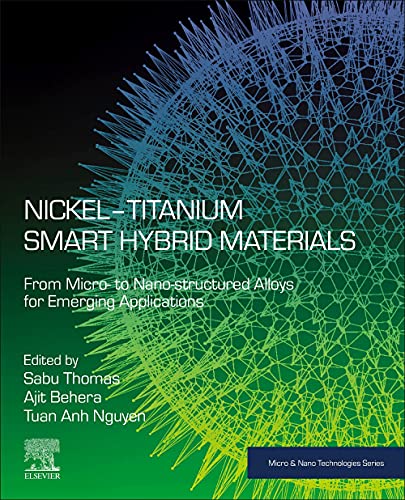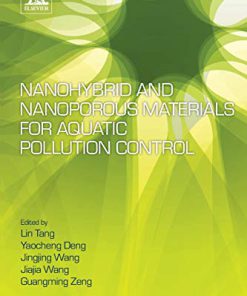Nickel Titanium Smart Hybrid Materials From Micro to Nano structured Alloys for Emerging Applications 1st Edition by Sabu Thomas, Ajit Behera, Tuan Anh Nguyen 0323911730 9780323911733
$50.00 Original price was: $50.00.$25.00Current price is: $25.00.
Nickel Titanium Smart Hybrid Materials From Micro to Nano structured Alloys for Emerging Applications 1st Edition by Sabu Thomas, Ajit Behera, Tuan Anh Nguyen – Ebook PDF Instant Download/Delivery: 0323911730, 9780323911733
Full download Nickel Titanium Smart Hybrid Materials From Micro to Nano structured Alloys for Emerging Applications 1st Edition after payment

Product details:
ISBN 10: 0323911730
ISBN 13: 9780323911733
Author: Sabu Thomas, Ajit Behera, Tuan Anh Nguyen
Nickel-Titanium Smart Hybrid Materials: From Micro- to Nano-structured Alloys for Emerging Applications describes advanced properties that can be adapted in NiTi-alloys. Nickel-Titanium (NiTi) systems are receiving wide demand in growing industries due to their smart, high-temperature or biocompatible behavior. These influenced behaviors are carefully described in the micro-scale and nanoscale range, with NiTi smart materials described on the basis of their shape memory effect (SME) and super-elastic (SE) properties for sensor and actuator application. This book discusses novel properties of nickel-titanium systems, helping materials scientists and engineers produce smart technologies and systems for the aeronautical, automobile, mechanical, healthcare and electronics industries.
- Describes the use of nanotechnology and microtechnology in nickel-titanium-based systems
- Outlines the major properties of Nickel-Titanium Nanoalloys
- Assesses the major challenges of manufacturing nickel-titanium nanoalloys at an industrial scale
Nickel Titanium Smart Hybrid Materials From Micro to Nano structured Alloys for Emerging Applications 1st Table of contents:
Part I: Fundamentals
1. NiTi-based smart micro- and nanoalloys: an introduction
Abstract
References
2. Methods for fabrication of NiTi micro- and nanoalloys
Abstract
2.1 Introduction
2.2 Magnetron sputtering
2.3 Pulsed laser deposition
2.4 Electrodeposition
2.5 Fabrication of NiTi micro- and nanodevices
2.6 Summary
References
3. Constitutive modeling of NiTi-based shape memory alloys
Abstract
3.1 Introduction
References
4. Cryo-treatment of NiTi alloys
Abstract
4.1 Introduction
4.2 Why cryogenic treatment is required for NiTi
4.3 Subcooling treatment and cryogenic treatments in NiTi
4.4 Microstructure and properties
4.5 Influencing parameters in NiTi cryogenic processing
4.6 Advantages and disadvantages of cryogenic processing
4.7 Summary and perspective
References
5. Heat treatment of NiTi alloys
Abstract
5.1 Requirements of heat treatment
5.2 Binary phase and TTT diagram of Ni-Ti
5.3 How is heat treatment performed?
5.4 Microstructure and phase transformation of NiTi by heat-treatment
5.5 Effect of heat treatment on the mechanical properties of NiTi alloys
5.6 Effect of heat treatment on corrosion resistance of NiTi alloys
5.7 Heat treatment parameters
References
Part II: Micro-/nanostructures and properties
6. NiTi superalloys
Abstract
6.1 Introduction
6.2 History
6.3 Alloying elements and their importance
6.4 Phases of NiTi superalloys
6.5 Mechanisms of strengthening
6.6 Manufacturing processes for NiTi superalloys
6.7 Applications
6.8 Summary and future scopes
References
7. NiTi-based ternary shape-memory alloys
Abstract
7.1 Introduction
7.2 NiTi phase diagram
7.3 Factors affecting the phase transformation temperatures
7.4 NiTi production methods
7.5 Effect of ternary additions
7.6 Conclusions and future scope
References
8. NiTi superhydrophobic materials
Abstract
8.1 Superhydrophobicity: science from nature
8.2 Nomenclature
8.3 Basic concepts
8.4 Processes for the preparation of a superhydrophobic surface
8.5 NiTi smart material
8.6 NiTi superhydrophobic surfaces
8.7 Conclusions
References
9. NiTi plasma spray coating
Abstract
9.1 Introduction
9.2 Classification of NiTi plasma spraying
9.3 Mechanism of NiTi coating
9.4 Factors affecting NiTi spraying
9.5 Thermodynamics associated with NiTi coating
9.6 Reaction with O2
9.7 Fabrication procedure
9.8 Microstructure and properties
9.9 Advantages and disadvantages
9.10 Applications
9.11 Summary and future perspectives
References
10. Biocompatibility of NiTi
Abstract
10.1 Introduction
10.2 Corrosion and NiTi implants
10.3 Biocompatibility studies
10.4 Application of NiTi biomaterials
10.5 Issues and challenges of NiTi implants
10.6 Summary and future scope
References
11. NiTi-based ternary alloys
Abstract
11.1 Introduction
11.2 Effect of additive elements
11.3 Major factors affecting the properties
11.4 Thermodynamics associated with additions
11.5 Fabrication procedure
11.6 Change to properties
11.7 Advantages and disadvantages
11.8 Summary and future perspectives
References
12. NiTi-based coupling devices
Abstract
12.1 Introduction
12.2 Advantages of an NiTi coupler over a conventional coupler
12.3 Design considerations
12.4 Fabrication of a nitinol coupler
12.5 NiTi-based alloy couplers
12.6 Heat treatment and postprocessing
12.7 Application of an NiTi-based coupler
12.8 Advantages and disadvantages of NiTi couplers
12.9 Conclusion
References
Part III: Emerging applications
13. Thermal spraying of NiTi alloy
Abstract
13.1 Introduction to thermal spraying
13.2 NiTi shape memory alloy
13.3 Atmospheric plasma spraying of NiTi
13.4 Vacuum plasma spraying of NiTi
13.5 Formation of NiTi intermetallics during thermal spraying
13.6 Defects during NiTi thermal spraying
13.7 Summary
References
14. Nickel–titanium smart hybrid materials for automotive industry
Abstract
14.1 Introduction
14.2 What are NiTi smart hybrid materials
14.3 Applications
14.4 Conclusions
References
15. Biomedical applications of NiTi alloys
Abstract
15.1 Introduction
15.2 Dentistry applications
15.3 Orthopedic applications
15.4 Intra-vascular stent applications
15.5 Guided wire and endoscope applications
References
16. Smart applications of NiTi shape memory alloy in biomedical industries
Abstract
16.1 Introduction into NiTi biomaterials
16.2 NiTi biocompatibility
16.3 Preferential texture of NiTi biomaterials
16.4 Modification of NiTi biomaterials
16.5 NiTi applications in the human body
16.6 Summary
References
17. NiTi smart alloys in electronic and electrical equipment
Abstract
17.1 Introduction
17.2 Modes of failure in electrical and electronics components
17.3 Fabrication procedure of NiTi in the electrical and electronics industries
17.4 Advantages and disadvantages
17.5 Applications
17.6 Summary
References
18. NiTi joining with other metallic materials
Abstract
18.1 Introduction to SMA joining
18.2 Classification of joining
18.3 Mechanism of joining
18.4 Factors affecting NiTi dissimilar joining
18.5 Thermodynamics associated with NiTi joining
18.6 Microstructure and properties
18.7 Advantages and disadvantages
18.8 Applications
18.9 Summary and future prospects
References
19. NiTi shape memory alloys: properties
Abstract
19.1 Introduction
19.2 Shape-memory effect
19.3 Superelasticity of NiTi
19.4 Crystallography aspects of NiTi
19.5 NiTi binary phase diagram
19.6 Mechanical aspects of NiTi
19.7 Thermal characteristics of NiTi
19.8 Wear resistance and hardness
19.9 Damping capacity of NiTi
19.10 Alloying elements in NiTi
People also search for Nickel Titanium Smart Hybrid Materials From Micro to Nano structured Alloys for Emerging Applications 1st:
nickel-titanium smart hybrid materials
smart metal alloys
micrometals materials
nitinol smart material
Tags:
Sabu Thomas,Ajit Behera,Tuan Anh Nguyen,Nickel
You may also like…
Technique - Nanotechnology
Uncategorized
Nanomaterials Recycling (Micro and Nano Technologies) 1st Edition Mahendra Rai (Editor)
Uncategorized
Engineering - Industrial Engineering & Materials Science
Technique - Nanotechnology
Engineering - Industrial Engineering & Materials Science
Technique - Nanotechnology
Chemistry - Physical Chemistry
Nano and Micro Scale Energetic Materials 2 Volumes 1st Edition Weiqiang Pang











